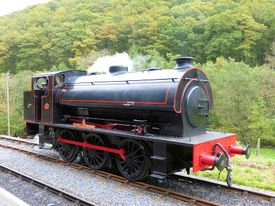WD 71516 Welsh Guardsman
| WD 71516 Welsh Guardsman | |
|---|---|
 WD 71516 (Gwili Railway, 2015) | |
| Built By | Robert Stephenson & Hawthorns |
| Configuration | 0-6-0ST |
| Status | Serviceable, temporarily resident |
| Loco Number | WD 71516 |
| Other Numbers | Works Number RSH 7170/1944 |
| History | |
| Built | 1944 |
| Designed By | Hunslet Engine Company |
| Type | WD Austerity |
| 1947 | Entered NCB service |
| 1980 | Preserved |
| 2013/14 | Overhauled and rededicated |
| 2020 | Arrived on SVR |
| Technical | |
| Length | 30ft 4" |
| Weight | 48t 5cwt |
| Tractive effort | 23.870 lb |
| Pressure | 170 lb/sq in |
WD 71516 "Welsh Guardsman" arrived on the SVR in February 2020 as a temporary resident.
The War Department Austerity 0-6-0ST was the standard World War II shunting engine, designed by the Hunslet Engine Company in Leeds and built between 1942 and 1946 to the requirements of the Ministry of Supply. A number of these engines were also built by sub-contractors including WD 71516. After the war construction continued for use in industry; a further small batch was also built for the War Department in the 1950s including former SVR resident WD 193 Shropshire.
Contents
WD 71516 in service
WD 71516 was built for the War Department by Robert Stephenson & Hawthorns in 1944 as Works Number 7170. After wartime service ended, the locomotive was bought by the National Coal Board in 1947, initially to work in Northumberland and subsequently at Cynheidre Colliery near Llanelli. From 1976 until 1980 the locomotive was retained at Pontarddulais as a source of spares, before being saved by the Welsh Industrial & Maritime Museum[1].
WD 71516 in preservation
The Welsh Industrial and Maritime Museum was located in Butetown, Cardiff and closed in 1998 with its exhibits redistributed.[2]
On arrival at Bronwydd Arms on the Gwili Railway, WD 71516 was rebuilt using parts from other locomotives including the boiler from Hunslet No. 3822 and the cab and tank of Bagnall No 2758. The locomotive was given its war department number 71516 and named "Welsh Guardsman" in a special ceremony at Bronwydd Arms.[1] The locomotive was last overhauled at Llangollen between 2011 and 2013,[3] after which it was rededicated at a ceremony at Bronwydd Arms on 9 June 2014.[1]
On 27 February 2020 WD 71516 arrived by road at Bridgnorth. The SVR announced that it had ...agreed to host Welsh Guardsman while the owner decides on the operating opportunities for the loco during the 2020 season. Bridgnorth Locomotive Works will undertake some examination and maintenance work and we will potentially have the chance to use the locomotive.[4]
The locomotive is owned by Felinfoel Brewery[1].
See also
References
- ↑ 1.0 1.1 1.2 1.3 Gwili Railway (retrieved 28 February 2020)
- ↑ Welsh Industrial and Maritime Museum on Wikipedia (Retrieved 29 February 2020)
- ↑ UK Locos (retrieved 28 February 2020)
- ↑ SVR Website (retrieved 28 February 2020)
Links
| ||||||||||||||||||||||||||||||||||||||||||||||||||||||||